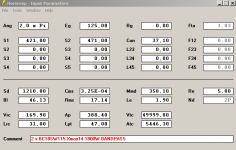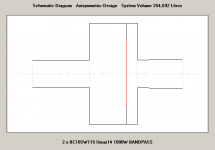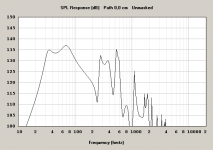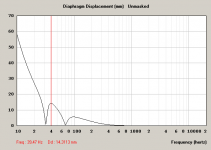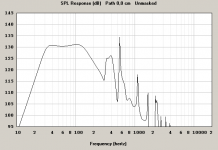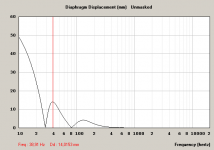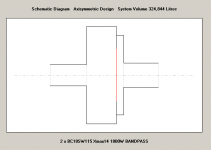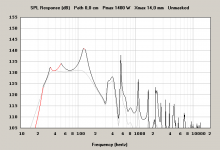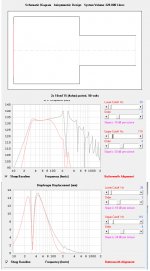Hi All,
I've been wondering what the optimum enclosure topology is when only the space occupied by the enclosure is the parameter of concern.
Let's say whe want an enclosure with a -3dB point of 30Hz, when amplifier power and amount of drivers (cost) are not an issue, what will be the design with the most linear output within the same volume?
I've been playing around with hornresp, and I keep coming back to the conclusion that simple bass reflex wins in this aspect; with a tapped horn I can gain 6dB over bassreflex, but the volume will be 4x times as big, so I could just use 4 bass relfex cabs, which will give me 6dB more output than the TH.
Am I seeing something wrong here or is this the right conclusion?
What would then, except driver/amplifier cost, be the advantage of using a tapped horn?
Thanks,
Kees
I've been wondering what the optimum enclosure topology is when only the space occupied by the enclosure is the parameter of concern.
Let's say whe want an enclosure with a -3dB point of 30Hz, when amplifier power and amount of drivers (cost) are not an issue, what will be the design with the most linear output within the same volume?
I've been playing around with hornresp, and I keep coming back to the conclusion that simple bass reflex wins in this aspect; with a tapped horn I can gain 6dB over bassreflex, but the volume will be 4x times as big, so I could just use 4 bass relfex cabs, which will give me 6dB more output than the TH.
Am I seeing something wrong here or is this the right conclusion?
What would then, except driver/amplifier cost, be the advantage of using a tapped horn?
Thanks,
Kees
That would probably be a bandpass with a very narrow passband. You can get gain in a narrow band of frequencies. I imagine that this is not what you are after, however. I think that your own conclusion is correct - that vented or PR systems are highest for a given volume. Not 100% sure on this however, but pretty sure.
The exact alignment of the vented enclosure also influences the efficiency. You would need to consult original papers on this I think. There is also the QB5 alignment that is described here:
QB5 Alignment page at Rod Elliot's web site
Not sure exactly how useful these are for subwoofers (the alignments are to be used for the woofer in a satellite that is paired with a true subwoofer), but it shows the influence of the alignment on max SPL output in the tables and through a worked example.
The exact alignment of the vented enclosure also influences the efficiency. You would need to consult original papers on this I think. There is also the QB5 alignment that is described here:
QB5 Alignment page at Rod Elliot's web site
Not sure exactly how useful these are for subwoofers (the alignments are to be used for the woofer in a satellite that is paired with a true subwoofer), but it shows the influence of the alignment on max SPL output in the tables and through a worked example.
Last edited:
Actually, now that I re-read your post, if you want a high linearity bass system in a compact package I suggest that you check out the Direct Servo systems from Rythmic Audio. These use a kind of motional feedback servo circuit that can be used with their drivers in a DIY system, or you can buy something fully assembled, ready-to-use. These are very good, low distortion subwoofers.
Thanks for the replies guys!
The question was above all meant as a sort of hyphothesis; "the vented box wins from other designs in volume vs linear output level"
Maybe the bandpass is actually superior in this aspect?
Let's make some restrictions, and maybe we can have a little group design rally;
- -3dB 30Hz-100Hz
- 2pi loading (floor)
- cabinet outher dimensions 58x58x118 cm (396 litres)
- number of drivers per cab: maximum 4
- minimum amplifier load: 2,7 ohm
- maximum continuous available amplifier power: 4000Watt/4ohm
- intended use: danceclub so 8 hours continuously full power (thermal issues)
So, with these restrictions, what do you think will be the design with the most linear longterm output level?
This is purely out of interest, maybe we can design something together which will be usable for the club guys out there.
Kees
The question was above all meant as a sort of hyphothesis; "the vented box wins from other designs in volume vs linear output level"
Maybe the bandpass is actually superior in this aspect?
Let's make some restrictions, and maybe we can have a little group design rally;
- -3dB 30Hz-100Hz
- 2pi loading (floor)
- cabinet outher dimensions 58x58x118 cm (396 litres)
- number of drivers per cab: maximum 4
- minimum amplifier load: 2,7 ohm
- maximum continuous available amplifier power: 4000Watt/4ohm
- intended use: danceclub so 8 hours continuously full power (thermal issues)
So, with these restrictions, what do you think will be the design with the most linear longterm output level?
This is purely out of interest, maybe we can design something together which will be usable for the club guys out there.
Kees
the enclosure is pretty small to expect stupendous output at 30hz. 35 is likely a better target, 40 would result in even more output.
Vented box, toss in the most insane drivers you can find. 4 0hm 18sound nlw9600 or bc sw115s would make uit the boom with 4000 watts per driver.
Vented box, toss in the most insane drivers you can find. 4 0hm 18sound nlw9600 or bc sw115s would make uit the boom with 4000 watts per driver.
The question was above all meant as a sort of hyphothesis; "the vented box wins from other designs in volume vs linear output level"
This is correct, ported boxes are the best bang for the buck (in terms of size vs output). And as pointed out by others, iso loaded drivers will allow the same output in an even smaller space, and passive radiators will save even more space.
While I can say with confidence that the above statement is true, things change a bit when moving from simulation to reality. Comparing (for example) a regular ported box vs a tapped horn, both using the same driver, usually when simulated at xmax both designs will have very similar output despite the tapped horn being several times larger. But once you figure in power and port compression the tapped horn starts showing it's strength. The tapped horn will require less power to reach xmax AND the driver is sitting in the middle of a massive "fanned" vent, so power and port compression are both much lower than the ported box. But the ported box still wins, as long as there is no limit on drivers and amps and the only concern is size.
Maybe the bandpass is actually superior in this aspect?
No.
Let's make some restrictions ...
Once you start making restrictions you are changing the game. Now instead of limiting just the size, you also want to limit the number of drivers and the amp power. With three conflicting goals the answer is much less obvious and starts to become dependent on the hidden details, like which driver is specified for the job and which arbitrary limits you decide to impose.
Last edited:
Thanks for the replies guys!
The question was above all meant as a sort of hyphothesis; "the vented box wins from other designs in volume vs linear output level"
Maybe the bandpass is actually superior in this aspect?
Let's make some restrictions, and maybe we can have a little group design rally;
- -3dB 30Hz-100Hz
- 2pi loading (floor)
- cabinet outher dimensions 58x58x118 cm (396 litres)
- number of drivers per cab: maximum 4
- minimum amplifier load: 2,7 ohm
- maximum continuous available amplifier power: 4000Watt/4ohm
- intended use: danceclub so 8 hours continuously full power (thermal issues)
So, with these restrictions, what do you think will be the design with the most linear longterm output level?
This is purely out of interest, maybe we can design something together which will be usable for the club guys out there.
Kees
Sounds like a quad of my 15" subs. Should be good for about 135db at 1m depending on how well they couple.
Where is Freddi when you need him????
I am sure that Freddi would say that a Karlson should also be considered. I have been doing a literature search and while some say that this design sucks, others say that it is the best - quite a range of opinions. I was particularly influenced by the comments of Mike Bates who has tried about every conceivable way to reproduce bass and he found the Karlson to be the best that he has tried.
I have never heard a Karlson myself, but I must admit I am curious.
Retsel
I am sure that Freddi would say that a Karlson should also be considered. I have been doing a literature search and while some say that this design sucks, others say that it is the best - quite a range of opinions. I was particularly influenced by the comments of Mike Bates who has tried about every conceivable way to reproduce bass and he found the Karlson to be the best that he has tried.
I have never heard a Karlson myself, but I must admit I am curious.
Retsel
Sounds like a quad of my 15" subs. Should be good for about 135db at 1m depending on how well they couple.
except for the fact that he can only fit 3 15s in that space he designated.
Allright,
usefull info.
I played around with 2xB&C18SW115 in bandpass cab, this is the result;
Tell me what you think.
Kees
At first glance I see a bunch of issues. First, the response you show is not consistent with your restrictions in post #6. Second, the t/s parameters don't look right. This link shows Bl is 30.3, Mms is 275 and Re is 5.3 for this driver. B&C 18SW115-8 18" Neodymium Subwoofer Speaker Driver | 294-575
The specs you used are not even close, where did you get them?
Third, 125V into 5 (or 5.3 or 2.5 or 2.65) ohms is not even close to 1800 watts.
I didn't get any further than a quick glance at what you did, there seem to be too many errors to bother looking further.
Justaguy, I stand corrected  this was the result of me playing around with hornresp and pressing "design by specification", hornresp came up with a superdriver which I forgot about.
this was the result of me playing around with hornresp and pressing "design by specification", hornresp came up with a superdriver which I forgot about.
I updated the design with your comments, and the proper T/S.
Kees
 this was the result of me playing around with hornresp and pressing "design by specification", hornresp came up with a superdriver which I forgot about.
this was the result of me playing around with hornresp and pressing "design by specification", hornresp came up with a superdriver which I forgot about.I updated the design with your comments, and the proper T/S.
Kees
Attachments
Thanks for the replies guys!
The question was above all meant as a sort of hyphothesis; "the vented box wins from other designs in volume vs linear output level"
Maybe the bandpass is actually superior in this aspect?
Let's make some restrictions, and maybe we can have a little group design rally;
- -3dB 30Hz-100Hz
- 2pi loading (floor)
- cabinet outher dimensions 58x58x118 cm (396 litres)
- number of drivers per cab: maximum 4
- minimum amplifier load: 2,7 ohm
- maximum continuous available amplifier power: 4000Watt/4ohm
- intended use: danceclub so 8 hours continuously full power (thermal issues)
So, with these restrictions, what do you think will be the design with the most linear longterm output level?
This is purely out of interest, maybe we can design something together which will be usable for the club guys out there.
Kees
I am going to game this captain Kirk style and throw a B&C Ipal 21" in that box. 4000 watts at 4ohm = 16000@1ohm so we have some serious amp headroom going for us.
the Keystone will go that loud and low with a single 18sw115.... as wil the xoc TH18, both come in at around 330 liters inside hornresp (same size as your bandpass box).
Heres a 328 liter Vented design 2x 18sw115s, with 90 volts (granted this is the 4 ohm version).
Heres a 328 liter Vented design 2x 18sw115s, with 90 volts (granted this is the 4 ohm version).
Attachments
the orignal Karlson loaded with vintage Altec and tuned low (~28Hz) like Exemplar with 2-3"ID elbow ducts is the best I've heard for home use - but its sensitivity on the low end is pretty much dictated by the rear chamber volume and system tuning. A hybrid Karlson such as Greg B's Karlsonator or a 1/4 wave tapped tqwt would probably have more output in the lower octave than the original (1951) K15 Karlson re-tuned.
bulk for bulk, same aspect ratio and for 30Hz - is the tapped horn any more efficient on the lows than the tapped tapered line?
bulk for bulk, same aspect ratio and for 30Hz - is the tapped horn any more efficient on the lows than the tapped tapered line?
A 2 cu ft 2nd order sealed box with an F3 of 30hz can only be 0.18% efficient (84.55dB).
A 2 cu ft 4th order vented box with an F3 of 30hz can only be 0.36% efficient (87.56dB).
A 2 cu ft 6th order vented box with an F3 of 30hz can only be 0.90% efficient (91.54dB).
That sort of leads me to a question - how would one calculate the required specs for a driver to be the best match for a tapped horn of particular net box size, bandwidth and low frequency cutoff. I know that there's a spreadsheet floating around to design the best TH for a driver, but how about vice-versa?
You have asked for "best" driver with four parameters:That sort of leads me to a question - how would one calculate the required specs for a driver to be the best match for a tapped horn of particular net box size, bandwidth and low frequency cutoff. I know that there's a spreadsheet floating around to design the best TH for a driver, but how about vice-versa?
1)Tapped horn use.
2)Particular net box size (of undefined size).
3)Particular bandwidth (of undefined range and frequency deviation).
4)Particular low frequency cutoff (without a defined frequency).
Additional "best" parameters could (and IMO should) include efficiency, sensitivity, distortion, and output potential.
To decide what is "best" requires placing a weighting value on each of the parameters, as well as defining each parameter.
The "best" could be nearly an infinite range of drivers (real or imaginary), dependent on the weighting of the parameters.
Art
- Status
- This old topic is closed. If you want to reopen this topic, contact a moderator using the "Report Post" button.
- Home
- Loudspeakers
- Subwoofers
- Most efficient topology when only enclosure volume is considered
